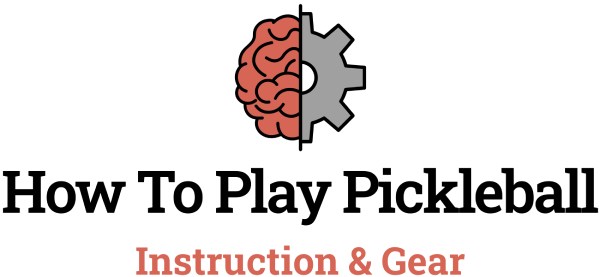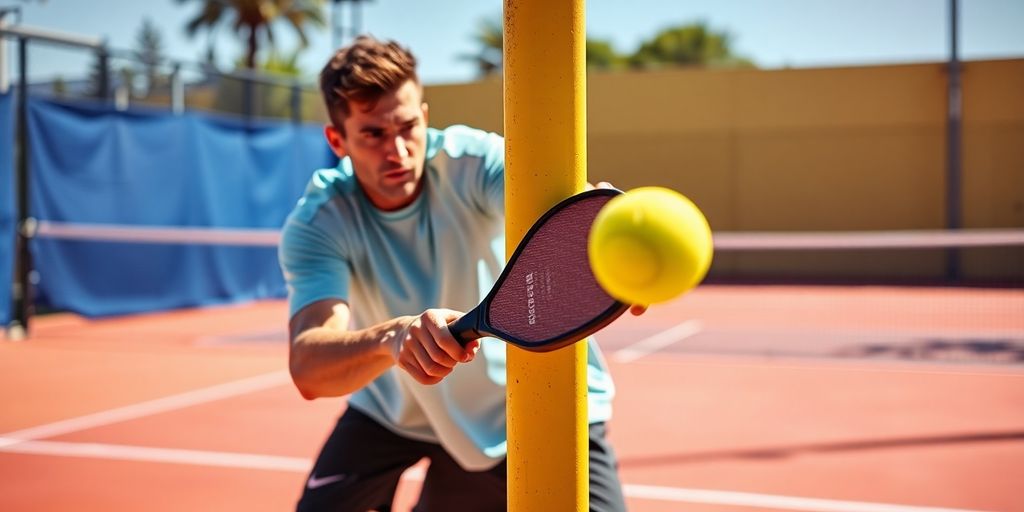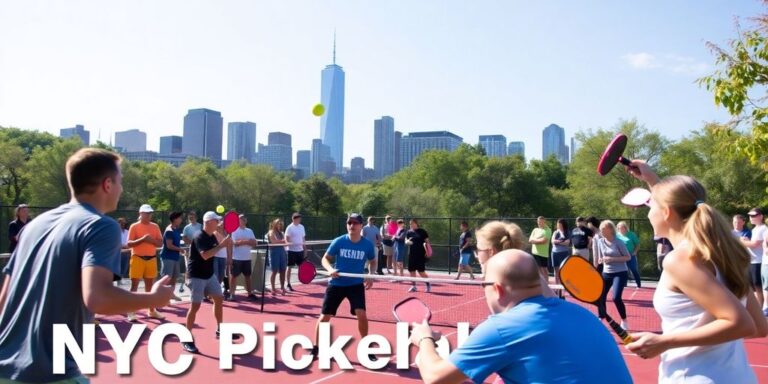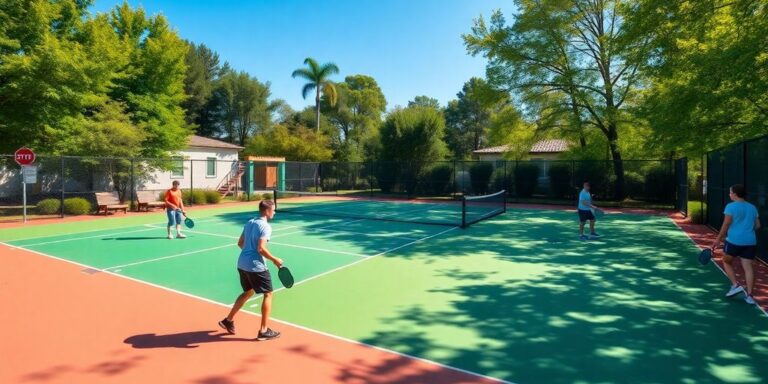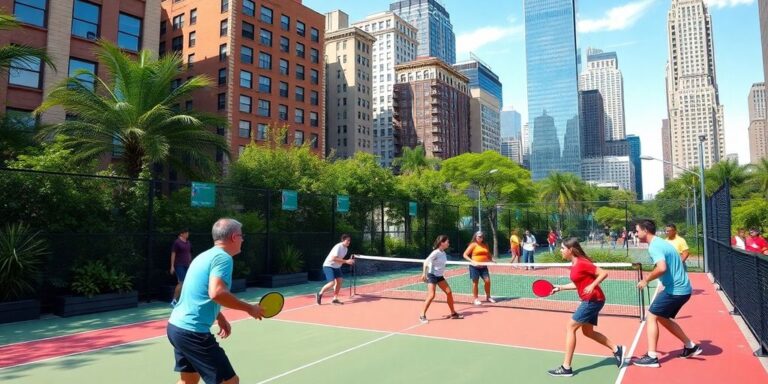If you’re looking to up your pickleball game, understanding the ATP shot is key. The Around the Post (ATP) shot is a unique and impressive move that can take your opponents by surprise. This article will break down the ins and outs of the ATP shot, including how to execute it, defend against it, and common pitfalls to avoid. Whether you’re a beginner or an experienced player, mastering this shot can give you an edge on the court.
Key Takeaways
- The ATP shot is a strategic move that goes around the net post, not over it.
- Timing and body positioning are crucial for successfully executing an ATP.
- Practicing your paddle control and grip can greatly improve your ATP shot.
- Watch your opponent’s body language to anticipate an ATP shot.
- Stay calm and focused during rallies to effectively counter an ATP.
Understanding ATP Pickleball Meaning
Definition of the ATP Shot
So, what exactly is an ATP in pickleball? Well, ATP stands for "Around The Post" shot. It’s when you hit the ball around the outside of the net post, instead of over the net. Think of it as a legal way to curve the ball into your opponent’s court when you’re pulled super wide. It’s one of those shots that looks really cool when done right, and it can definitely catch your opponents off guard. You’ll often see it when someone hits a really sharp angle, pulling you way out wide. That’s when the opportunity arises to try and loop it around the post. If you’re new to the game, understanding pickleball terminology like this is a great first step.
Importance of the ATP in Gameplay
The ATP isn’t just a flashy move; it can be a game-changer. It forces your opponent to cover more ground and react quickly to an unexpected angle. Plus, it can be a great way to turn a defensive situation into an offensive one. When you pull off an ATP successfully, it can really shift the momentum of the game. It’s also just plain fun to hit! It’s one of those shots that, when you nail it, you feel like you’ve really leveled up your game. But it’s not just about the flash; it’s about adding another tool to your arsenal that can help you win points. Understanding the essential rules of pickleball will help you know when you can use this shot.
Common Misconceptions About ATP
There are a few things people often get wrong about the ATP. First, some players think it’s an illegal shot, but as long as the ball doesn’t touch the net or the post, it’s perfectly legal. Second, many beginners think it’s a super-advanced shot that’s only for pros. While it does take practice, players of all levels can learn to execute it. Finally, some people think you should always go for the ATP when you’re wide, but that’s not true either. Sometimes, a dink or a lob is a better option. It’s all about reading the situation and making the right choice. It’s important for new players to have a comprehensive understanding of pickleball rules to avoid these misconceptions.
The ATP is a high-risk, high-reward shot. It can win you the point outright, but it can also lead to an easy point for your opponent if you mess it up. It’s important to practice it and understand when it’s the right play to make.
Key Factors to Hitting the Perfect ATP

So, you wanna nail that Around-the-Post shot, huh? It’s not just about swinging wildly and hoping for the best. There are a few key things you gotta keep in mind if you want to actually pull it off consistently. Let’s break it down.
Anticipation and Timing
Okay, first things first: you gotta see it coming. Anticipation is huge. You can’t just react; you need to predict. Watch your opponent like a hawk. Are they setting up for a wide shot? Are they leaning a certain way? The earlier you can spot the opportunity, the better your chances of getting into position. Timing is everything, too. You need to move at the right moment, not too early and not too late. It’s a feel thing, but practice helps a ton. Recognizing the signs of an ATP is the first step.
Body Positioning and Footwork
Footwork, footwork, footwork! I can’t stress this enough. You need to be quick and agile to get into the right spot. Forget flat feet; stay on your toes. Shuffle, don’t cross your feet, and keep your weight balanced. Your body position is also key. You want to be facing the direction you want the ball to go, not just square to the net. Think about opening up your stance to give yourself more room to swing. Good footwork is crucial for the ATP shot.
Angle and Trajectory
This is where the magic happens. You’re not just hitting the ball; you’re trying to thread the needle around the post. The angle of your paddle face is super important. You want to keep the ball low, so it clears the post but doesn’t give your opponent an easy shot. Trajectory is all about feel. You need to practice hitting the ball with different amounts of spin to control its path. Aim to keep the ball low as it passes the post to minimize your opponent’s chance of returning it. It’s a delicate balance, but once you get it, it’s so satisfying. Understanding the essential rules for pickleball can also help you strategize your shots better.
Getting the angle right is tough, but visualizing the shot beforehand can really help. I like to imagine the ball’s path in my head before I even start moving. It sounds a little cheesy, but it works for me!
Techniques for Executing the ATP Shot
Paddle Control and Grip
Okay, so you want to nail that ATP? It all starts with how you’re holding your paddle. A relaxed but firm grip is key. You don’t want to be squeezing it like you’re trying to crush it, but you also don’t want it slipping out of your hand mid-swing. Think about it like holding a bird – firm enough so it doesn’t fly away, but gentle enough not to hurt it. Experiment with different grips to see what feels most natural and gives you the best control. A continental grip is often recommended, but find what works for you.
Using Spin Effectively
Spin can be your best friend when hitting an ATP. Applying topspin can help bring the ball down quickly, allowing you to hit it with more power and still keep it in the court. Sidespin can also be useful for bending the ball around the net post. It’s all about experimenting and finding what works best for you in different situations.
- Topspin: Helps the ball dip down.
- Sidespin: Curves the ball around the net.
- Backspin: Can be used defensively to slow the ball down.
Practicing with Purpose
Don’t just mindlessly hit ATPs over and over. Practice with a purpose. Set up specific drills that mimic game situations. Focus on your footwork, paddle control, and shot placement. Record yourself and analyze your technique. Are you getting into position quickly enough? Is your paddle face angled correctly? Are you following through properly? Pickleball doubles strategies can be useful here.
Practicing the ATP shot isn’t just about hitting the ball around the post; it’s about developing a feel for the shot, understanding the angles, and building the muscle memory needed to execute it consistently under pressure. Focus on quality over quantity, and always be mindful of what you’re trying to achieve with each shot.
Here’s a simple drill you can try:
- Have a partner feed you wide balls.
- Focus on getting into position quickly and hitting the ATP with good form.
- Vary the speed and angle of the feeds to challenge yourself.
Defending Against an ATP Shot

Okay, so someone’s trying to pull off an ATP pickleball shot on you. Don’t panic! It can be tough to return, but it’s definitely not impossible. The key is to be prepared and react quickly. Let’s break down how to handle it.
Recognizing the Signs of an ATP
First things first, you gotta see it coming. Is your opponent way off to the side of the court? Did you hit a shot that pulled them super wide? These are big clues. If they’re scrambling near the sideline with a clear shot around the net post, an ATP is likely. Watch their body language and paddle position. Are they setting up for a cross-court dink, or are they angling for something more dramatic? Recognizing the setup is half the battle.
Positioning Yourself to Counter
Okay, you suspect an ATP is coming. Now what? Don’t just stand there! Shift your weight slightly towards the side they’re hitting from. Take a step or two back from the kitchen line. This gives you a little more time to react to that crazy angle. Most players just watch, but you need to move! Think about where the ball is likely to land, not just where it is now. Adjust your court positioning accordingly.
Maintaining Control During the Rally
So, the ATP is hit. Now it’s all about staying calm and making a play. Don’t overreach! Try to meet the ball out in front of you. Use a compact swing and focus on getting the ball back into play, even if it’s not a perfect shot. A defensive dink is often a good option here. The goal is to reset the point and not give up an easy winner. Remember, even pros don’t hit perfect ATPs every time. Sometimes, just getting the ball back is a win. Also, try to avoid hitting shots with sharp angles that give your opponents an easy opportunity to hit an ATP. Consider these points:
- Anticipate the shot early by watching your opponent’s positioning.
- Move your feet to get into the best possible position to return the shot.
- Stay balanced and avoid overreaching.
Defending against an ATP isn’t about hitting a spectacular winner. It’s about smart positioning, quick reactions, and staying in the point. Focus on getting the ball back safely and forcing your opponent to make another play. Don’t get discouraged if they pull off a few winners – just keep grinding and wait for your opportunity. Mastering defensive skills is key.
Common Mistakes to Avoid When Attempting an ATP
Okay, so you’re going for the ATP. Awesome! It’s a flashy, effective shot when done right. But trust me, there are definitely some pitfalls to watch out for. I’ve seen players make these mistakes over and over, and it can be frustrating. Let’s break down some common errors so you can avoid them.
Overcommitting to the Shot
One of the biggest mistakes I see is players just going all-in on the ATP without thinking. It’s like they see the opportunity and completely forget about everything else. You can’t just abandon your court position and leave yourself vulnerable. If you miss the shot, or even if you make it but it’s not a great shot, you’re going to be in a tough spot. Remember, it’s just one point! Sometimes, the smarter play is to let it go or hit a safer shot. Think about the risk versus reward. Is that around the post shot really worth it?
Neglecting Footwork
Footwork, footwork, footwork! I can’t stress this enough. The ATP requires you to move quickly and efficiently to get into the right position. If your footwork is sloppy, you’re going to be off-balance, and your shot will suffer. You need to be able to shuffle laterally, adjust your feet quickly, and maintain a stable base. Don’t just reach for the ball with your paddle; move your feet! Here’s a quick checklist:
- Are you moving your feet early when you see the wide shot developing?
- Are you staying low to the ground for better balance?
- Are you taking small, quick steps to adjust your position?
I remember one time, I was playing against this guy who was obsessed with hitting ATPs. But his footwork was terrible. He’d stumble all over the place, and his shots were all over the map. It was actually kind of funny to watch, but it also showed me how important footwork is for this shot.
Ignoring Opponent’s Positioning
This is a big one. You can’t just focus on hitting the ATP; you need to be aware of where your opponents are on the court. Are they cheating towards the middle? Are they expecting the ATP? If they are, you might want to reconsider and hit a different shot. The element of surprise is key with the ATP. If your opponents are ready for it, it’s not going to be nearly as effective. Pay attention to their paddle position and body language. Are they leaving the line open? If so, maybe a dink is a better option. Don’t be predictable!
Drills to Improve Your ATP Skills
Alright, so you want to get better at hitting those around-the-post shots? Good! It’s a game-changer, but it takes practice. Here are some drills that I’ve found helpful. They’re not magic, but they’ll get you closer to nailing that perfect ATP.
Partner Drills for Precision
Partner drills are great because they simulate real game situations. You can’t just practice in a vacuum; you need someone feeding you the ball. The key here is communication and consistency.
- Wide Angle Feed: Have your partner feed you balls that force you wide, mimicking a cross-court dink. Focus on getting into position quickly and executing the ATP shot.
- Target Practice: Set up cones or targets near the sidelines. Aim for specific spots to improve your angle control. This helps with precision, not just power.
- ATP Recovery: After hitting the ATP, your partner should immediately hit the ball back. This forces you to recover quickly and stay in the point. It’s not just about the fancy shot; it’s about what comes next.
Solo Drills for Technique
Don’t underestimate solo practice. It’s where you really dial in your technique without the pressure of a partner or game. It’s all about repetition and muscle memory.
- Shadow Swings: Practice your ATP swing without a ball. Focus on your footwork, body rotation, and paddle path. Do this in front of a mirror to check your form.
- Wall Drills: Use a wall to simulate ball returns. Practice your footwork and paddle control as you move laterally and hit the ball around an imaginary post. This helps with reaction time and consistency.
- Cone Drills: Set up cones to mimic the net and the sideline. Practice moving around them and hitting imaginary ATP shots. This helps with spatial awareness and angle judgment.
Video Analysis for Improvement
This is where things get next-level. Recording yourself and watching it back can be brutal, but it’s also incredibly effective. You see things you’d never notice otherwise.
- Record Your Sessions: Use your phone or a camera to record your practice sessions. Pay attention to your footwork, paddle position, and body rotation.
- Compare to Pros: Watch videos of professional pickleball players hitting ATP shots. Compare their technique to yours and identify areas for improvement. There are tons of videos online, so find a few that resonate with you.
- Focus on One Thing: Don’t try to fix everything at once. Pick one aspect of your game to focus on each session. For example, one week you might focus on footwork, and the next week on paddle control. Baby steps!
Remember, the ATP isn’t just a flashy shot. It’s a strategic tool. Don’t overuse it, and don’t force it. Use these drills to build a solid foundation, and the ATP will become a natural part of your game. Understanding ATP pickleball meaning is the first step, but practice is what makes it real.
The Role of Mental Preparation in ATP Success
Pickleball isn’t just about physical skill; it’s a mental game too. When you’re trying to master the around-the-post (ATP) shot, your mental state is just as important as your technique. It’s about staying focused, managing pressure, and believing in your ability to pull off this tricky shot. Let’s explore how mental preparation can make or break your ATP game.
Visualizing the Shot
Before you even step onto the court, start picturing yourself hitting that perfect ATP. Mental imagery can be a powerful tool. See the ball coming towards you, visualize your footwork, and imagine the satisfying feeling of the paddle connecting with the ball as it curves around the post. This mental rehearsal primes your brain and body for the real thing.
- Enhances muscle memory.
- Reduces anxiety.
- Improves reaction time.
Staying Calm Under Pressure
ATP shots often happen in high-pressure situations. Maybe it’s a tight game, or you’re trying to impress someone. Whatever the reason, it’s easy to get flustered. Learning to stay calm is key. Deep breathing exercises, positive self-talk, and focusing on the present moment can help you keep your cool. Remember, even the pros make mistakes. It’s how you recover that matters. Mental performance training for pickleball can help reduce errors.
Building Confidence Through Practice
Confidence comes from knowing you’ve put in the work. The more you practice your ATP shots, the more confident you’ll become in your ability to execute them in a game. Don’t just go through the motions; practice with purpose. Focus on your technique, analyze your mistakes, and celebrate your successes. Each successful shot builds your confidence and makes you more likely to try the ATP in a real match. Two-player pickleball requires teamwork, and confidence in your shots helps.
Mental toughness is like a muscle; the more you use it, the stronger it gets. Don’t be afraid to challenge yourself and push your limits. With consistent practice and a positive mindset, you can turn the ATP shot from a risky gamble into a reliable weapon in your pickleball arsenal.
Mental preparation is super important for success in ATP tournaments. It helps players stay focused and calm, which can make a big difference in their performance. By practicing mental skills, athletes can boost their confidence and handle pressure better. If you want to learn more about how mental training can help you or someone you know, visit our website for tips and resources!
Wrapping It Up
So, there you have it! The ATP shot is a thrilling move that can really change the game in pickleball. It’s not just about showing off your skills; it’s a smart tactic that can catch your opponents off guard. Sure, it takes practice to get it right, but with the tips we talked about, you can start working on it. Don’t shy away from trying it out during your matches. Embrace the challenge, and you might just find that the ATP shot becomes a key part of your game. Now, get out there and start practicing!
Frequently Asked Questions
What does ATP mean in pickleball?
ATP stands for ‘Around the Post.’ It’s a special shot where you hit the ball around the net post instead of over the net.
When should I try an ATP shot?
You should attempt an ATP shot when your opponent hits the ball wide, pulling you to the sideline, giving you a chance to hit around the post.
Is the ATP shot hard to master?
Yes, the ATP shot can be tricky to learn, but with practice and the right technique, players at all levels can improve.
How can I improve my ATP shot?
You can practice by focusing on your footwork, body position, and paddle control. Drills with a partner can help too.
What should I avoid when hitting an ATP?
Don’t overcommit to the shot or neglect your footwork. Also, be aware of where your opponent is positioned.
Can I defend against an ATP shot?
Yes, you can defend against an ATP by watching your opponent’s body language and being ready to return the ball with control.
